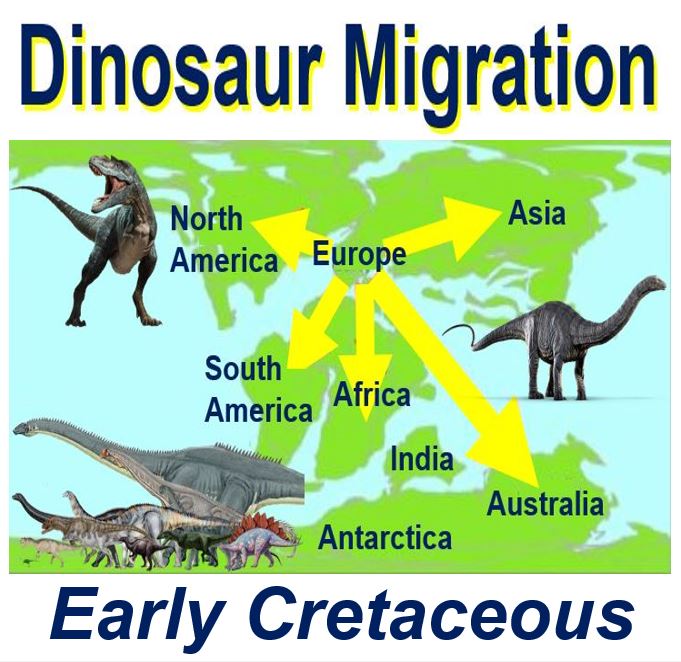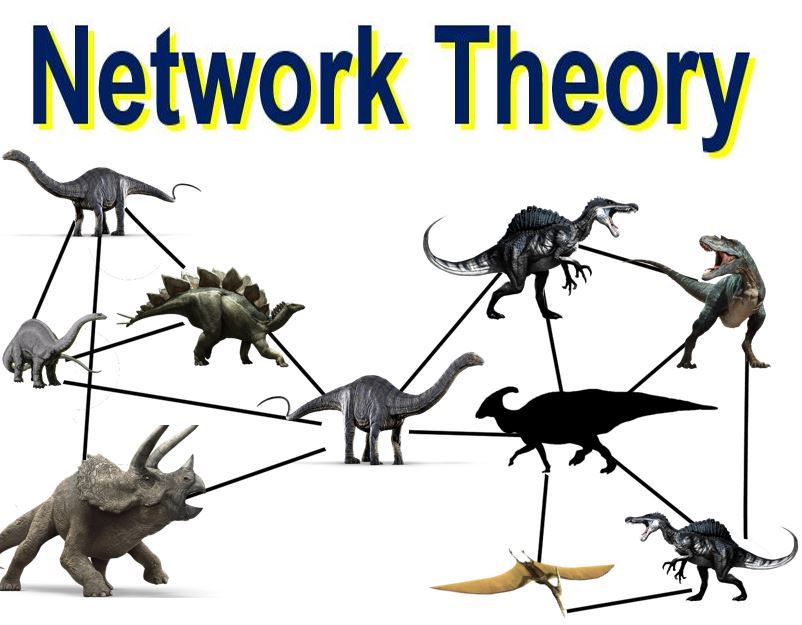There was a mass exodus of dinosaurs from Europe from 125 to 100 million years ago, a team of scientists says. During that period – the Early Cretaceous – dinosaur families were leaving in large numbers, while no new families were migrating into Europe.
The scientists, from the Universities of Leeds and Bath in England, used a ‘network theory’ for the first time to visually illustrate global dinosaur movements during the Mesozoic Era.
Study lead Dr Alex Dunhill, who works at the University of Leeds’ School of Earth and Environment, and colleagues wrote about their study and conclusions in the Journal of Biogeography (citation below).
 During the Early Cretaceous (100-125m years ago), dinosaurs were moving out of Europe while none were migrating into the continent.
During the Early Cretaceous (100-125m years ago), dinosaurs were moving out of Europe while none were migrating into the continent.
Dinosaurs continued migrating after Pangaea split
The authors say their findings reaffirm previous studies suggesting that after the ‘supercontinent’ Pangaea split into land masses that were separated by oceans, dinosaurs continued migrating to all parts of the world.
Dr. Dunhill said:
“We presume that temporary land bridges formed due to changes in sea levels, temporarily reconnecting the continents.”
“Such massive structures – spanning, for example, from Indo-Madagascar to Australia – may be hard to imagine. But over the timescales that we are talking about, which is in the order of tens of millions of years, it is perfectly feasible that plate tectonic activity gave rise to the right conditions for such land bridges to form.
The research team used the Paleobiology Database in this study – it contains every documented and accessible dinosaur fossil that has so far been discovered anywhere in the world.
 This was the first time ‘Network Theory’ was used on dinosaurs. According to the University of Cambridge, Network Theory is: “A technique for analysing structure in a system of interacting agents, represented as a network.”
This was the first time ‘Network Theory’ was used on dinosaurs. According to the University of Cambridge, Network Theory is: “A technique for analysing structure in a system of interacting agents, represented as a network.”
They then cross-mapped fossil records for the same dinosaur families from different continents with different periods of time, revealing connections that show us how they had migrated.
In some regions of the world – for example Europe – there are extensive dinosaur fossil records from a long history of palaeontology digs, while other regions remain largely unexplored.
To help factor in this disparity in fossil records, which would otherwise distort their findings, the scientists applied a filter to the database records to only count the first time that a dinosaur family connection happened between two continents.
Continental splitting reduced (not stopped) dinosaur migration
Their findings support a widely-held idea that, although continental splitting significantly reduced intercontinental dinosaur migration, it did not halt it altogether.
They were surprised to find that all connections between Europe and other continents during the Early Cretaceous (125 to 100 million years ago) were out-going, i.e. while families of dinosaurs were leaving Europe, no new ones were coming in.
Regarding this migratory pattern, Dr. Dunhill said:
“This is a curious result that has no concrete explanation. It might be a real migratory pattern or it may be an artefact of the incomplete and sporadic nature of the dinosaur fossil record.”
Network theory is commonly used by researchers in computer science to quantify internet data, such as friend connections in Facebook and other social networking websites. Only recently has it been applied to biology – this is the first time it was used on dinosaur research.
Co-author, Dr. James Sciberras, who works at the University of Bath’s Department of Biology and Biochemistry, said regarding the use of network theory:
“Network theory has been studied in physics for a number of years, however it is finally permeating into other disciplines. This idea that most things can, and should, be considered in the context of the whole system will lead to some exciting new findings in a wide range of fields.”
Citation: “Dinosaur biogeographical structure and Mesozoic continental fragmentation: a network-based approach,” James Sciberras, Holly Narey, Jordan Bestwick & Alexander M. Dunhill. Journal of Biogeography. 25 April 2016. DOI: 10.1111/jbi.12766.
Video – Europe’s largest predatory dinosaur
This video (no narrative) shows Europe’s largest predatory dinosaur that we know of. Fossil remains of the 33-foot-long (10-meter-long) brute – called Torvosaurus gurneyi – were discovered in Portugal.
